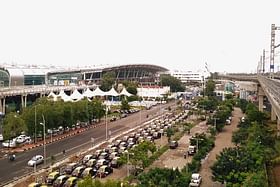The report will encompass everything from the master plan for the site to social impact studies, environmental management plans, environmental impact assessments, surveys, and financial models.
US Consultancy Firm Louis Berger has started work on a detailed Techno-Economic Feasibility Report (TEFR) for Chennai’s proposed second airport in Parandur in the Kancheepuram district.
The TEFR report will comprise everything from a master plan, survey, and financial model to a social impact study for the second airport.
To begin the process, the Tamil Nadu Industrial Development Corporation (TIDCO) hired Louis Berger in December last year to prepare a comprehensive techno-economic report and assist with securing the necessary clearances from various agencies over the next several years.
It was in August 2022 that Chief Minister M K Stalin announced that a greenfield airport would be built in Parandur, located around 15 km northeast of Kanchipuram, at an investment of Rs 20,000 crore with a capacity to handle 100 million passengers per annum.
The Parandur location was selected as the site for the project due to the present airport’s impending capacity saturation and other passenger issues.
According to The Hindu report, the firm has already started work on the detailed report and is expected to deliver it within the next 6-8 months.
A high-level expert committee, formed by the government, to examine potential environmental issues since the Parandur site has several waterbodies has conducted meetings.
The committee tasked with evaluating the impacts of possible floods in the area has moved a step forward.
The Water Resources Department, in charge of providing data about rainfall, geological conditions, and flood levels, has recently submitted the necessary details to the committee.
The officials monitoring the development of the site have said that the report will be comprehensive and inclusive of numerous details.
From the master plan for the site to social impact studies, environmental management plans, environmental impact assessments, surveys, and financial models, the report will encompass everything.
The team will ensure that no stone is left unturned while presenting the final report.
High-Level Committee
The project with a total area of 4,791 acres covering about 13 villages has seen vociferous protests with residents consistently objecting to it as they will have to give up their land, severely affecting their livelihoods.
Also, out of the total land area required for the airport, more than 50 per cent (2,605 acre) are wetlands. Many activists and experts, apart from the villagers, had voiced their dissent, fearing that it may cause serious damage to the environment.
To put things into perspective, residents of Ekanapuram village, one of the 13 villages to be affected by the Parandur airport passed a resolution against the project during a gram sabha meeting held on 26 January this year — this was the fourth time such a resolution was passed.
Subsequently, the state government assured the setting up of a technical committee to analyse and recommend measures for mitigating the impact and conserving water bodies and also find an effective solution for the land acquisition issues for the villagers, including the farmers.
Following this, in March 2023, a seven-member high-level committee (HLC) was constituted to look into the environmental and land acquisition issues.
The committee headed by a retired IAS officer has hydrogeological experts from IIT Madras and Anna University and officials from the State government including the Water Resources Department, TIDCO, Kancheepuram Collectorate and Commissionerate of Land Administration
The expert committee has started examining the detailed data submitted to them regarding the land, the number and extent of water bodies and other factors impacting the environment.
Subsequently, the HLC will conduct further meetings and field-level inspections before submitting its report within six months.


